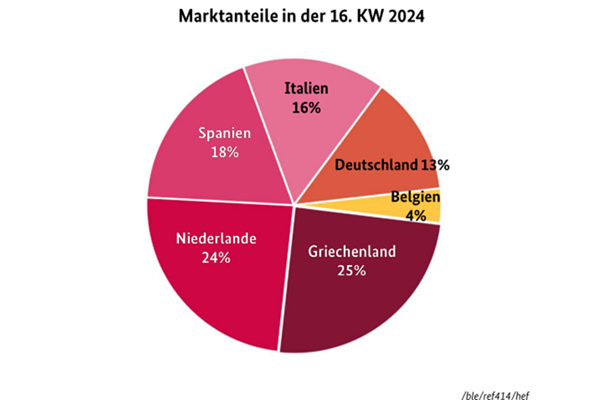The markets were adequately supplied with dominant Greek and Dutch strawberries. Italian and Spanish offers followed in importance, according to BLE, the latter having noticeably reduced in the reporting week. The availability of domestic batches, on the other hand, had significantly expanded. Belgium only participated with small quantities in the market activities. The bad weather had noticeably limited storage options. Nevertheless, prices tended to rise at the beginning of the week. From Wednesday onwards, discounts were observed in many places before the valuations increased again at some points on Friday. Dutch, Belgian, and domestic products were at the top of the price range, with a significant gap to the competition. Italian batches disappeared from the assortment in Cologne over the course of the week; in Berlin, they presented themselves quite unevenly in terms of quality. Spanish articles cost only 1.20 EUR per 500-g package in Frankfurt. In Munich, their relevance was rather small, as the goods were tied to retail programs.

Apples
German deliveries dominated the scene, with Elstar, Jonagold, Braeburn, and Boskoop forming the basis of the offer. Italian deliveries complemented the marketing, while French, Polish, Dutch, and Belgian loads did not go beyond a complementary character.
Pears
South African imports prevailed, especially Abate Fetel, Packham's Triumph, and Rosemarie. From Argentina, mainly Abate Fetel and Williams Christ came, and from Chile, Abate Fetel.
Grapes
South African fruits dominated the scene, followed by Indian, Chilean, and Peruvian. The marketing went smoothly, and demand could be satisfied without difficulties.
Lemons
Spanish Primofiori and higher quality Verna prevailed, Turkish and Greek loads were at most supplementary. In Cologne and Munich, there were exclusively Spanish offers.
Bananas
Business was uneven: In Hamburg, the quotations remained constant, as supply and demand adequately balanced each other. In Cologne, only the premium brand from Costa Rica became more expensive.
Cauliflower
The assortment was primarily composed of German, Italian, and Belgian batches. Domestic candidates are now gradually replacing imports from Italy and France. The latter completed the current product range, in which Spanish and Dutch batches played only a minimal role.
Lettuce
German, Belgian, and Italian products were available for head lettuces, while French batches could also be accessed for mixed salads. For iceberg lettuces, there were exclusively Spanish articles. The availability was generally sufficient to meet the demand.
Cucumbers
The markets were well supplied with domestic, Dutch, and Belgian cucumbers, with the Belgian products especially available in all common weight gradings. The domestic ones had rather smaller calibers. Spain had withdrawn from marketing.
Tomatoes
There was a wide range of assortments available, with a multitude of countries participating. Besides the main importers, the Netherlands and Belgium, Spain continued to play a significant role, Italy followed in terms of importance.
Bell peppers
The Spanish season is nearing its end: The offers could no longer consistently convince in terms of quality, disappeared from the marketing in places and were overall displaced from the first place in terms of quantity by the Dutch deliveries.
Asparagus
Domestic stalks continued to dominate visibly. Both with white and violet, as well as green offers, European imports played at most a secondary role. Spain and Italy were primarily involved in the green produce, the Netherlands and Greece in the light-colored products.
Source: BLE
